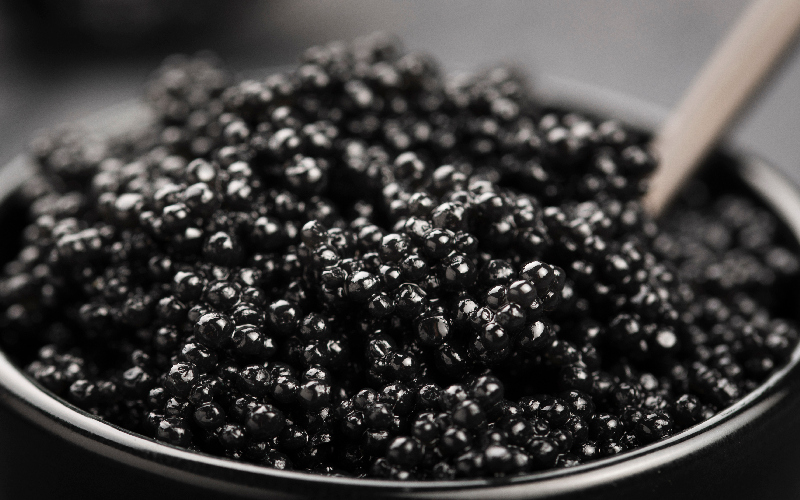Baerii caviar, also known as Siberian sturgeon caviar, has captured the attention of caviar enthusiasts worldwide for its distinctive taste, sustainable sourcing, and affordability compared to other types of luxury caviar. Sourced from the Siberian sturgeon (Acipenser baerii), this delicacy is known for its delicate flavor and smooth, almost buttery texture. As a choice that combines quality and environmental responsibility, Baerii caviar is an excellent introduction to the world of fine caviar and an increasingly popular option for chefs, gourmands, and first-time caviar eaters alike.
What is Baerii Caviar?
Baerii caviar comes from the Siberian sturgeon, a species native to Siberian river systems and freshwater bodies in Russia. While the Baerii sturgeon takes about seven to ten years to mature—a shorter period than its counterparts, such as the beluga or osetra sturgeon—it still produces a high-quality, delicious caviar with a refined profile.
The eggs of Baerii caviar are medium-sized and typically range from light to dark gray, sometimes with brown or olive tones. Their small, firm texture and mildly earthy, creamy taste make them a wonderful addition to any caviar lover’s palate. Because of the sustainable practices often associated with Baerii sturgeon farming, this caviar offers an ethical choice for those conscious of environmental impact without compromising on luxury.
The Growing Popularity of Baerii Caviar
While Baerii caviar has long been appreciated in Europe and Russia, its reputation has recently grown in international markets. Its combination of quality, ethical production, and lower price compared to other types of caviar has driven its popularity. High-end restaurants, culinary events, and even home chefs have embraced Baerii caviar for its versatility and balanced flavor profile.
For those new to caviar, Baerii provides an approachable introduction to the world of fine caviar. It is less briny than some other types, making it palatable for a wide range of tastes, and its cost allows a more accessible entry point into luxury dining.
How is Baerii Caviar Produced?
The farming of Baerii sturgeon is particularly well-suited to sustainable practices. Baerii sturgeons are often farmed in closed, eco-friendly systems that recycle water and prevent the need for harmful chemicals or antibiotics. Additionally, farming methods allow for controlled environments where the fish can grow and mature under ideal conditions, which enhances the quality of the caviar.
Many farms now use the “no-kill” method, allowing sturgeon to release eggs naturally, meaning they can continue producing caviar over time. This not only ensures a steady supply of roe but also reduces the need for wild sturgeon fishing, helping to protect endangered species.
What Sets Baerii Caviar Apart?
Several unique characteristics make Baerii caviar stand out from other types of caviar. Here are some of the features that make it a favorite among caviar aficionados:
-
Delicate Flavor Profile
Baerii caviar has a delicate, nutty flavor with earthy undertones, balanced by a mild salinity that doesn’t overpower the taste. Its subtle flavors make it a versatile choice for pairing with various foods and beverages.
-
Smooth, Buttery Texture
The eggs are small to medium-sized and firm, with a smooth, creamy mouthfeel. The texture complements the caviar’s taste, allowing it to melt beautifully on the palate.
-
Aromatic and Balanced
Unlike stronger, saltier caviars, Baerii has an aromatic but gentle flavor, which makes it accessible for people who may be new to caviar. The earthy tones add depth, while the buttery notes round off the flavor for a balanced experience.
-
Sustainable Sourcing
As mentioned, Baerii caviar is often produced using sustainable farming practices, making it an ethical choice. Knowing that Baerii caviar is eco-friendly and sourced responsibly allows consumers to enjoy it without the environmental concerns that accompany some other varieties.
-
Affordability
Baerii caviar is generally more affordable than beluga or osetra caviar, making it an attractive option for those seeking luxury on a budget. It’s a great way to experience a taste of caviar’s elegance without the high price tag.
How to Serve and Enjoy Baerii Caviar
Caviar, especially Baerii, is best enjoyed in a minimalist style to appreciate its unique flavors fully. Here’s how to serve it to ensure the best possible experience:
-
Temperature
Serve Baerii caviar chilled, but avoid freezing it. Ideally, keep it at 0–4°C (32–39°F). Use a dish placed over ice to maintain the caviar’s temperature as it’s served.
-
Non-Metallic Serving Tools
Use mother-of-pearl, bone, or glass utensils when handling caviar. Metal spoons can alter the flavor of the caviar, as they may impart a metallic taste.
-
Traditional Accompaniments
Serve Baerii caviar with traditional accompaniments like blinis (small pancakes), crème fraîche, and toast points. Hard-boiled eggs, finely diced onions, and chives can add subtle flavors without overpowering the caviar.
-
Pairing Options
To complement Baerii’s earthy notes, serve it with a crisp, dry champagne or a chilled vodka, as both drinks enhance the experience without overshadowing the caviar’s delicate taste. Alternatively, a dry white wine with mineral notes can also complement Baerii caviar beautifully.
-
Presentation
For an elegant presentation, serve Baerii caviar in a crystal or glass caviar dish. Caviar presentation often adds to the experience, elevating it from a meal to an event.
Baerii Caviar in Culinary Uses
Thanks to its smooth texture and gentle flavor, Baerii caviar is ideal for both classic and modern culinary applications. Here are some innovative ways to incorporate it into dishes:
-
Caviar-Topped Canapés
For an elegant appetizer, place a small dollop of crème fraîche on a blini or potato rosti, topped with a spoonful of Baerii caviar.
-
Gourmet Deviled Eggs
Top deviled eggs with a small portion of Baerii caviar for a luxurious twist on a classic dish.
-
Seafood Pairings
Baerii caviar pairs well with other seafood like scallops, oysters, and smoked salmon. A spoonful of Baerii caviar over oysters can elevate this simple delicacy.
-
Creamy Pasta
A touch of Baerii caviar over creamy pasta, like spaghetti alla carbonara, can add a luxurious finish to a traditional Italian dish. The caviar’s mild saltiness complements the creaminess of the sauce.
How to Store Baerii Caviar
Proper storage is essential to preserving the quality of Baerii caviar. Here are some tips:
-
Keep it Cool
Always store Baerii caviar in the coldest part of the refrigerator, ideally between 0 and 4°C. The lower the temperature, the longer the caviar will stay fresh.
-
Seal it Well
Once opened, Baerii caviar should be consumed within 24 hours for the best flavor. However, if it’s vacuum-sealed and unopened, it can last up to 4–6 weeks, depending on the producer’s recommendation.
-
Avoid Freezing
Freezing caviar can alter its delicate texture, making the eggs burst upon thawing. Avoid freezing if possible, but if you must, only freeze unopened containers for a short period.
Conclusion
Baerii caviar offers a remarkable opportunity for both newcomers and seasoned caviar lovers to experience the luxury of caviar at a more accessible price point. Its mild, earthy flavors and buttery texture provide an elegant dining experience that complements both traditional and contemporary dishes.
Sustainably produced and responsibly sourced, Baerii caviar aligns with modern culinary values, allowing you to indulge in a delicacy that respects environmental conservation. Whether enjoyed with classic accompaniments or as part of a unique dish, Baerii caviar promises to elevate any occasion, combining refined taste with ethical appeal.








